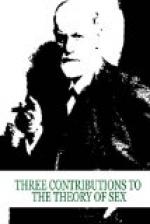The new sexual aim in the man consists in the discharging of the sexual products; it is not contradictory to the former sexual aim, that of obtaining pleasure; on the contrary, the highest amount of pleasure is connected with this final act in the sexual process. The sexual impulse now enters into the service of the function of propagation; it becomes, so to say, altruistic. If this transformation is to succeed its process must be adjusted to the original dispositions and all the peculiarities of the impulses.
Just as on every other occasion where new connections and compositions are to be formed in complicated mechanisms, here, too, there is a possibility for morbid disturbance if the new order of things does not get itself established. All morbid disturbances of the sexual life may justly be considered as inhibitions of development.
THE PRIMACY OF THE GENITAL ZONES AND THE FORE-PLEASURE
From the course of development as described we can clearly see the issue and the end aim. The intermediary transitions are still quite obscure and many a riddle will have to be solved in them.
The most striking process of puberty has been selected as its most characteristic; it is the manifest growth of the external genitals which have shown a relative inhibition of growth during the latency period of childhood. Simultaneously the inner genitals develop to such an extent as to be able to furnish sexual products or to receive them for the purpose of forming a new living being. A most complicated apparatus is thus formed which waits to be claimed.
This apparatus can be set in motion by stimuli, and observation teaches that the stimuli can affect it in three ways: from the outer world through the familiar erogenous zones; from the inner organic world by ways still to be investigated; and from the psychic life, which merely represents a depository of external impressions and a receptacle of inner excitations. The same result follows in all three cases, namely, a state which can be designated as “sexual excitation” and which manifests itself in psychic and somatic signs. The psychic sign consists in a peculiar feeling of tension of a most urgent character, and among the manifold somatic signs the many changes in the genitals stand first. They have a definite meaning, that of readiness; they constitute a preparation for the sexual act (the erection of the penis and the glandular activity of the vagina).
The Sexual Tension—The character of the tension of sexual excitation is connected with a problem the solution of which is as difficult as it would be important for the conception of the sexual process. Despite all divergence of opinion regarding it in psychology, I must firmly maintain that a feeling of tension must carry with it the character of displeasure. For me it is conclusive that such a feeling carries with it the impulse to alter the psychic situation,




